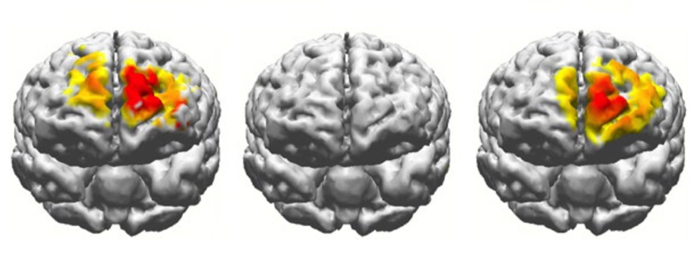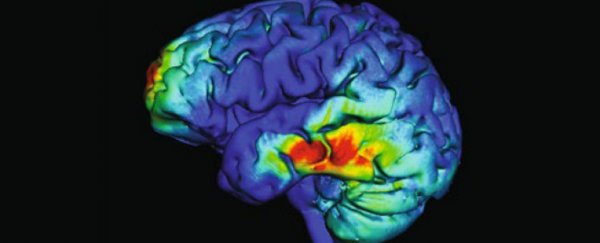Scientists have used a noninvasive form of electrostimulation to boost working memory in older people, effectively giving 70-year-olds the thinking abilities of their 20-year-old selves, at least temporarily.
Working memory is the cognitive resource responsible for decision-making at any given moment, letting us retain and access useful and relevant information, such as names, phone numbers, and where we've put things.
Unfortunately, this resource declines with age, and not just in those with significant cognitive deterioration, such as dementia, but in healthy people too experiencing the normal neurocognitive effects of ageing.
The good news is, this decline in working memory doesn't seem to be permanent.
"Age-related changes are not unchangeable," neuroscientist Robert Reinhart from Boston University told The Guardian.
"We can bring back the superior working memory function that you had when you were much younger."
 (Reinhart Lab/Boston University)
(Reinhart Lab/Boston University)
Above: EEG representations of working memory (left to right) in a 20-year-old without stimulation, older person without stimulation, older person with stimulation.
In Reinhart's new research, his lab administered noninvasive electrical current to both old and young people, to see how it affected their working memory performance.
As part of the experiment, 42 young participants (aged 20–29) and 42 older adults (60–76) were given a memory task in which they had to identify differences between images they were shown.
Predictably, given what we know about working memory deficits that come with age, the older participants were markedly slower and less accurate at the task than the younger adults. Age is but one way of explaining this contrast, though.
Another is that certain rhythms in our brains fail to coordinate successfully in older people; these rhythms help different parts of the brain relay information and memories.
Specifically, neuroscientists currently think that slow, low-frequency rhythms called theta rhythms need to sync up with faster, high-frequency gamma rhythms between prefrontal and temporal areas in the brain for our working memory to function efficiently.
This synchronisation is called phase-amplitude coupling (PAC), but while it looks to drop off as we age, a form of electrostimulation called transcranial alternating-current stimulation (tACS) appears to resynchronise these uncoupled brain circuits.
In the study, electroencephalography (EEG) measurements of the participants' brain activity showed greater synchronisation in the young adults.
"The results suggest that theta-gamma PAC in younger adults is behaviourally significant, predictive of subsequent working-memory success," the authors explain in their paper.
But that's not all. When the researchers used a targeted form of tACS stimulation called HD-tACS on the participants, these synchronisation deficiencies disappeared.
"HD-tACS appeared to eliminate age-related impairment in working-memory accuracy," the researchers write.
"This behavioural improvement was sufficient to remove the original group difference in working-memory accuracy, as older adults after stimulation exhibited a mean accuracy level statistically indistinguishable from that of younger adults at baseline."
With just 25 minutes of the stimulation technique, the technique boosted the older participants' performance in the memory task to the level of the younger adults, and the effects lasted up to 50 minutes after the stimulation ended.
The researchers say these improvements were mirrored with the reinstated theta–gamma coupling in the older participants' EEG readings, and the benefits look to extend to young people too, not just older people.
In another test, the young adult participants who performed poorly on the working memory exercise received the HD-tACS stimulation, and it improved their results also.
"We showed that the poor performers who were much younger, in their 20s, could also benefit from the same exact kind of stimulation," Reinhart says in a statement.
"We could boost their working memory even though they weren't in their 60s or 70s."
While it will take a lot more research before we fully understand the mechanisms involved here – let alone be able to develop a treatment based on the research – the findings could be a big step forward in addressing working memory deficits in the world's ageing population.
"The results that emerge from the study raise interesting questions about the brain activity that supports working memory and its mechanism of action," says neuroscientist Nir Grossman from Imperial College London, who wasn't involved with the research.
"Regardless of the exact brain activity and mechanism involved, the sustained improvement in working memory that was observed after the short stimulation period may potentially elude to future research and rehabilitation potential."
For Reinhart, the next steps are to look at how repeated doses of the stimulation might affect people, and to try to explore how the mechanisms actually work in animal models.
With time, and further positive results, the researchers say it's possible we could be looking at a whole new spectrum of potential research and treatment options.
"It's wild to think that we can target the electricity of a brain circuit the same way we would target a neurotransmitter chemical in the brain," Reinhart says.
The findings are reported in Nature Neuroscience.
